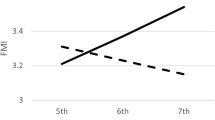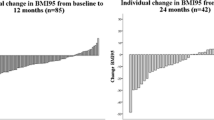Abstract
Purpose
Impact of lifestyle modification on obesity control during adolescence, a period of significant physical growth and development, is less quantitatively evaluated. Therefore, we investigated the impact of changes in reported energy intake and physical activity on anthropometrics and body composition in adolescents.
Methods
Participants were obese adolescents aged 11–18 years. All of them have a body mass index (BMI) ≥ 95th percentile specific for age and gender according to the 2000 CDC Growth Charts. The intervention consists of supervised physical activity, structured nutrition education and dietary modification, and behavioral support in 6 months. Hundred and forty-five obese adolescents completed the study.
Results
Compared to baseline, significant reductions in body weight (−1.4 kg, p < 0.001) and BMI (−0.1 kg/m2, p < 0.001) were observed at 6 months. When compared to expected growth trajectories on the 2000 CDC Growth Charts, body weight and BMI were reduced by 3.6 kg and 1.5 kg/m2, respectively, in boys and 5.6 kg and 1.9 kg/m2 in girls. Age was inversely associated with changes in weight (β = −1.48 kg, p < 0.01) and BMI (β = −0.32 kg/m2, p = 0.03). There was a dose–response relationship between reduction in energy intake and weight loss. A decrease of 100 kcal/day was significantly associated with reductions in body weight 0.30 kg, BMI 0.09 kg/m2, and BMI Z score 0.01 (all p < 0.01). Physical activity was not significantly associated with changes in anthropometrics or body composition.
Conclusions
Reduction in energy intake was a significant predictor of obesity reduction in these adolescents. A quantitative evaluation of adolescent weight loss programs should account for natural growth and development.

Similar content being viewed by others
Abbreviations
- BIA:
-
Bioelectric impedance analysis
- BMI:
-
Body mass index
- CDC:
-
Centers for disease control and prevention
- DXA:
-
Dual X-ray absorptiometry
References
Ogden CL, Carroll MD, Curtin LR, Lamb MM, Flegal KM (2010) Prevalence of high body mass index in US children and adolescents, 2007–2008. JAMA 303(3):242–249
l’Allemand-Jander D (2010) Clinical diagnosis of metabolic and cardiovascular risks in overweight children: early development of chronic diseases in the obese child. Int J Obes (Lond) 34(Suppl 2):S32–S36
Dietz WH (1998) Health consequences of obesity in youth: childhood predictors of adult disease. Pediatrics 101(3 Pt 2):518–525
Oude Luttikhuis H, Baur L, Jansen H, Shrewsbury VA, O’Malley C, Stolk RP, Summerbell CD (2009) Interventions for treating obesity in children. Cochrane Database Syst Rev 1:CD001872
Luttikhuis OH, Baur L, Jansen H, Shrewsbury VA, O’Malley C, Stolk RP, Summerbell CD (2009) Interventions for treating obesity in children. Cochrane Database Syst Rev 1:CD001872
Bleich SN, Ku R, Wang YC (2011) Relative contribution of energy intake and energy expenditure to childhood obesity: a review of the literature and directions for future research. Int J Obes (Lond) 35(1):1–15
Harris KC, Kuramoto LK, Schulzer M, Retallack JE (2009) Effect of school-based physical activity interventions on body mass index in children: a meta-analysis. CMAJ 180(7):719–726
Centers for Disease Control and Prevention, National Center for Health Statistics (2000) CDC growth charts: United States. http://www.cdc.gov/growthcharts/
Willett W (1990) Nutritional epidemiology. Oxford University Press, New York
Johnson RK, Driscoll P, Goran MI (1996) Comparison of multiple-pass 24-hour recall estimates of energy intake with total energy expenditure determined by the doubly labeled water method in young children. J Am Diet Assoc 96(11):1140–1144
Chinapaw MJ, Mokkink LB, van Poppel MN, van Mechelen W, Terwee CB (2010) Physical activity questionnaires for youth: a systematic review of measurement properties. Sports Med 40(7):539–563
Bean MK, Mazzeo SE, Stern M, Evans RK, Bryan D, Ning Y, Wickham EP 3rd, Laver J (2011) Six-month dietary changes in ethnically diverse, obese adolescents participating in a multidisciplinary weight management program. Clin Pediatr (Phila) 50(5):408–416
Kotler DP, Burastero S, Wang J, Pierson RN Jr (1996) Prediction of body cell mass, fat-free mass, and total body water with bioelectrical impedance analysis: effects of race, sex, and disease. Am J Clin Nutr 64(3 Suppl):489S–497S
Hosking J, Metcalf BS, Jeffery AN, Voss LD, Wilkin TJ (2006) Validation of foot-to-foot bioelectrical impedance analysis with dual-energy X-ray absorptiometry in the assessment of body composition in young children: the EarlyBird cohort. Br J Nutr 96(6):1163–1168
Kalarchian MA, Levine MD, Arslanian SA, Ewing LJ, Houck PR, Cheng Y, Ringham RM, Sheets CA, Marcus MD (2009) Family-based treatment of severe pediatric obesity: randomized, controlled trial. Pediatrics 124(4):1060–1068
Papadaki A, Linardakis M, Larsen TM, van Baak MA, Lindroos AK, Pfeiffer AF, Martinez JA, Handjieva-Darlenska T, Kunesova M, Holst C et al (2010) The effect of protein and glycemic index on children’s body composition: the DiOGenes randomized study. Pediatrics 126(5):e1143–e1152
Duckworth LC, Gately PJ, Radley D, Cooke CB, King RF, Hill AJ (2009) RCT of a high-protein diet on hunger motivation and weight-loss in obese children: an extension and replication. Obesity (Silver Spring) 17(9):1808–1810
U.S. Department of Agriculture and U.S. Department of Health and Human Services (2010) Dietary guidelines for Americans, 2010, 7th edn. U.S. Government Print Office, Washington, DC, December 2010
Ho M, Garnett SP, Baur LA, Burrows T, Stewart L, Neve M, Collins C (2013) Impact of dietary and exercise interventions on weight change and metabolic outcomes in obese children and adolescents: a systematic review and meta-analysis of randomized trials. JAMA Pediatr 167(8):759–768
Rolland-Cachera MF, Thibault H, Souberbielle JC, Soulie D, Carbonel P, Deheeger M, Roinsol D, Longueville E, Bellisle F, Serog P (2004) Massive obesity in adolescents: dietary interventions and behaviours associated with weight regain at 2 y follow-up. Int J Obes Relat Metab Disord 28(4):514–519
Gutin B, Barbeau P, Owens S, Lemmon CR, Bauman M, Allison J, Kang HS, Litaker MS (2002) Effects of exercise intensity on cardiovascular fitness, total body composition, and visceral adiposity of obese adolescents. Am J Clin Nutr 75(5):818–826
Ebbeling CB, Leidig MM, Sinclair KB, Hangen JP, Ludwig DS (2003) A reduced-glycemic load diet in the treatment of adolescent obesity. Arch Pediatr Adolesc Med 157(8):773–779
Carels RA, Young KM, Coit C, Clayton AM, Spencer A, Wagner M (2008) Skipping meals and alcohol consumption. The regulation of energy intake and expenditure among weight loss participants. Appetite 51(3):538–545
Daley AJ, Copeland RJ, Wright NP, Roalfe A, Wales JK (2006) Exercise therapy as a treatment for psychopathologic conditions in obese and morbidly obese adolescents: a randomized, controlled trial. Pediatrics 118(5):2126–2134
Sazonov ES, Schuckers S (2010) The energetics of obesity: a review: monitoring energy intake and energy expenditure in humans. IEEE Eng Med Biol Mag 29(1):31–35
Thivel D, Aucouturier J, Doucet E, Saunders TJ, Chaput J-P (2013) Daily energy balance in children and adolescents. Does energy expenditure predict subsequent energy intake? Appetite 60(1):58–64
Acknowledgments
The authors thank the TEENS program participants and their parents and gratefully acknowledge Ms. Janet Delorme for her role as Program Coordinator. This study was supported by funding from Virginia Premier Health Plan, Inc., the American Heart Association, Ronald McDonald House Charities and the YMCA of Greater Richmond. Additional Support was provided by the National Institutes of Health (NIH) through CTSA award No. UL1TR000058 from the National Center for Advancing Translational Sciences [to VCU] and K23HD053742 from the Eunice Kennedy Shriver National Institute of Child Health and Human Development [to EPW]. Its contents are solely the responsibility of the authors and do not necessarily represent official views of the NIH. The study is registered with ClinicalTrials.Gov NCT00167830 and NCT00562263.
Conflict of interest
None.
Author information
Authors and Affiliations
Corresponding author
Rights and permissions
About this article
Cite this article
Ning, Y., Yang, S., Evans, R.K. et al. Changes in body anthropometry and composition in obese adolescents in a lifestyle intervention program. Eur J Nutr 53, 1093–1102 (2014). https://doi.org/10.1007/s00394-013-0612-9
Received:
Accepted:
Published:
Issue Date:
DOI: https://doi.org/10.1007/s00394-013-0612-9




